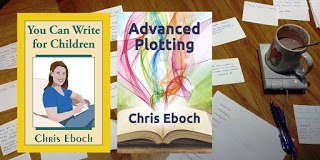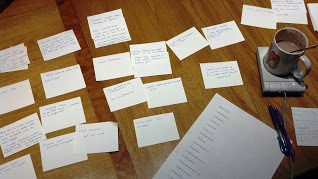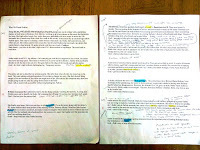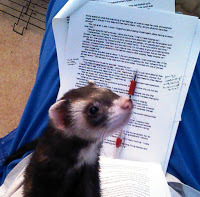Editing Your Novel during #NaNoEdMo – The Big Picture - #Writing #KidLit
 In honor of #NaNoEdMo (National Novel Editing Month), I'm sharing some advice from
You Can Write for Children
: A Guide to Writing Great Stories, Articles, and Books for Kids and Teenagers.
In honor of #NaNoEdMo (National Novel Editing Month), I'm sharing some advice from
You Can Write for Children
: A Guide to Writing Great Stories, Articles, and Books for Kids and Teenagers. The book market is more competitive than ever. Editors with mile-high submission piles can afford to choose only exceptional manuscripts. Authors who self-publish must produce work that is equal to releases from traditional publishers. And regardless of their publishing path, authors face competition from tens of thousands of other books. Serious authors know they must extensively edit and polish their manuscripts.
 For many writers, a new manuscript is their “baby.” You love it, and it may be hard to think of it as anything less than perfect. But you wouldn’t send your newborn baby out into the world and expect it to survive on its own. You help your children grow up, teaching them, gently correcting misbehavior, and helping them express their wonderful selves. As your children grow older, you can step back a bit and see them as individuals in their own right, separate from you. Once they are grown, you can send them off into the world, perhaps still worrying at times but with confidence that they can survive on their own.
For many writers, a new manuscript is their “baby.” You love it, and it may be hard to think of it as anything less than perfect. But you wouldn’t send your newborn baby out into the world and expect it to survive on its own. You help your children grow up, teaching them, gently correcting misbehavior, and helping them express their wonderful selves. As your children grow older, you can step back a bit and see them as individuals in their own right, separate from you. Once they are grown, you can send them off into the world, perhaps still worrying at times but with confidence that they can survive on their own.Editing a manuscript is similar. You need to distance yourself enough from the work that you can see it for what it is – not what you dreamed it would be, but what is actually on the page. Then you guide and shape it, perhaps with help from others. You release it into the world when you’re confident the story can survive on its own, without you there to explain or defend it.
The Big Picture
 Wading through hundreds of novel pages trying to identify every problem at once is intimidating and hardly effective. Even editing a picture book, short story, or article can be overwhelming if you try to address every issue at once. The best self-editors break the editorial process into steps. They also develop practices that allow them to step back from the manuscript and see it as a whole.
Wading through hundreds of novel pages trying to identify every problem at once is intimidating and hardly effective. Even editing a picture book, short story, or article can be overwhelming if you try to address every issue at once. The best self-editors break the editorial process into steps. They also develop practices that allow them to step back from the manuscript and see it as a whole.Editor Jodie Renner recommends putting your story away for a few weeks after your first complete draft. During that time, share it with a critique group or beta readers. (Beta readers give feedback on an unpublished draft. They are not necessarily writers, so they give a reader’s opinion.) Ask your advisors to look only at the big picture: “where they felt excited, confused, curious, delighted, scared, worried, bored, etc.,” Renner says. During your writing break, you can also read books, articles, or blog posts to brush up on your craft techniques.
Then collect the feedback and make notes, asking for clarification as needed. Consider moving everyone’s comments onto a single manuscript for simplicity. This also allows you to see where several people have made similar comments, and to choose which suggestions you will follow. At this point, you are only making notes, not trying to implement changes.
In my book Advanced Plotting, I suggest making a chapter by chapter outline of your manuscript so you can see what you have without the distraction of details. For each scene or chapter, note the primary action, important subplots, and the mood or emotions. By getting this overview of your novel down to a few pages, you can go through it quickly looking for trouble spots. You can compare your outline to The Hero’s Journey or scriptwriting three-act structure to see if those guidelines inspire any changes. (Get this Plot Arc Exercise as a free downloadable Word document on my website.)
 As you review your scenes, pay attention to anything that slows the story. Where do you introduce the main conflict? Can you eliminate your opening chapter(s) and start later? Do you have long passages of back story or explanation that aren’t necessary? Does each scene have conflict? Are there scenes out of order or repetitive scenes that could be cut? Make notes on where you need to add new scenes, delete or condense boring scenes, or move scenes.
As you review your scenes, pay attention to anything that slows the story. Where do you introduce the main conflict? Can you eliminate your opening chapter(s) and start later? Do you have long passages of back story or explanation that aren’t necessary? Does each scene have conflict? Are there scenes out of order or repetitive scenes that could be cut? Make notes on where you need to add new scenes, delete or condense boring scenes, or move scenes.Colored highlighter pens (or the highlight function on a computer) can help you track everything from point of view changes to clues in a mystery to thematic elements. Highlight subplots and important secondary characters to make sure they are used throughout the manuscript in an appropriate way. Cut or combine minor characters who aren’t necessary.
Using Your Notes
Once you have an overview of the changes you want, revise the manuscript for these big picture items: issues such as plot, structure, characterization, point of view, and pacing. Renner recommends you then reread the entire manuscript, still focusing on the big picture. Depending on the extent of your changes, you may want to repeat this process several times.
During this stage of editing, consider market requirements if you plan to submit the work to publishers. Is your word count within an appropriate range for the genre? Are you targeting a publisher that has specific requirements? If you’re writing a romance, will the characters’ arcs and happy ending satisfy those fans? If you have an epic fantasy, is the world building strong and fresh? If your thriller runs too long, can it be broken into multiple books, or can you eliminate minor characters and subplots?
Once you’ve done all you can, you may want to hire an editor. You could also send the manuscript to new beta readers or critique partners. People who have not read the manuscript before might be better at identifying how things are working now. (See my blog posts on Critiques for tips on when and how to use family and friends, other writers, and professional editors for feedback.)
 Editing Tips:
Editing Tips:Don’t try to edit everything at once. Make several passes, looking for different problems. Start big, then focus in on details.
Try writing a one- or two-sentence synopsis. Define your goal. Do you want to produce an action-packed thriller? A laugh-out-loud book that will appeal to preteen boys? A richly detailed historical novel about a character’s internal journey? Identifying your goal can help you make decisions about what to cut and what to keep.
Next make a scene list, describing what each scene does. · Do you need to make major changes to the plot, characters, setting, or theme (fiction) or the focus of the topic (nonfiction)?· Does each scene fulfill the synopsis goal? How does it advance plot, reveal character, or both? · Does each scene build and lead to the next? Are any redundant? If you cut the scene, would you lose anything? Can any secondary characters be combined or eliminated? · Does anything need to be added or moved? Do you have a length limit or target?· Can you increase the complications, so that at each step, more is at stake, there’s greater risk or a better reward? If each scene has the same level of risk and consequence, the pacing is flat and the middle sags.
 You can get the extended version of this essay, and a lot more, in You Can Write for Children: A Guide to Writing Great Stories, Articles, and Books for Kids and Teenagers. Order for Kindle, in paperback, or in Large Print paperback.
Advanced Plotting
also has advice on editing novels.
You can get the extended version of this essay, and a lot more, in You Can Write for Children: A Guide to Writing Great Stories, Articles, and Books for Kids and Teenagers. Order for Kindle, in paperback, or in Large Print paperback.
Advanced Plotting
also has advice on editing novels.Chris Eboch writes fiction and nonfiction for all ages, with over 30 traditionally published books for children. Learn more at www.chriseboch.com or her Amazon page. Chris also writes novels of suspense and romance for adults under the name Kris Bock; read excerpts at www.krisbock.com.
Published on March 01, 2021 05:00
No comments have been added yet.



